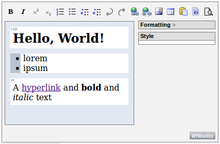WYSIWYM
WYSIWYM is the abbreviation for the principle " W hat Y ou S ee I s W hat Y ou M ean" ( English for "What you see is what you mean"). The term WYGIWYM " W hat Y ou G et I s W hat Y ou M ean" ("What you get is [what] you mean") is less common .
WYSIWYM displays the text on the screen in such a way that it is clear what purpose the formatting should serve, e.g. B. Chapter heading, enumeration, list. In contrast, WYSIWYG (“What You See Is What You Get”) illustrates the final output of the document; B. in the form of a PDF or DVI .
This type of formatting is used when you want to leave the details of the formatting to a ready-made stylesheet . This makes the formatting of the entire document much more consistent and appealing. Furthermore, formatting tasks and other classic problems of most WYSIWYG environments, e.g. B. jumping paragraphs, incorrect or jumping formatting, instability, etc. relieved. He can thus concentrate more on creating the content.
advantages
WYSIWYM processing is preferred if many or complex documents are to be processed in their individual components. This separation enables the division of labor to be carried out in the areas of data, logic and layout. For example, the content- related data can be structured in XML by the author , while another person is responsible for the arrangement and formatting of the document in XSL / XSL-FO and CSS . Since the source texts are often written in plain text formats, they are more accessible for version control (e.g. SVN ). The split also makes the individual components easier to reuse. An XSL stylesheet can be applied to different XML documents, for example, while an XML document can be formatted with different stylesheets for different output media without changing the content. This is a clear advantage over WYSIWYG editors, in which data, logic and layout are much more closely linked.
Applications
Programs that are based on the WYSIWYM principle include:
- the LaTeX - frontend LyX
- the DocBook project, where the content is structured in XML and the formatting is implemented using XSL (T)
Also markup languages (such as ( X ) HTML or MediaWiki markup) provide in the broadest sense - if one of awards that directly affect the layout, apart - WYSIWYM represents.
While WYSIWYG and WYSIWYM were never found in one editor in the past, attempts have recently been made to combine the advantages of both systems and offer both perspectives. This development takes place primarily in the area of XML and XSL editors, where, in addition to classic source text editing, editing in the formatted view is also possible (e.g. Altova XMLspy , oXygen or the VEX plug-in for Eclipse ).
